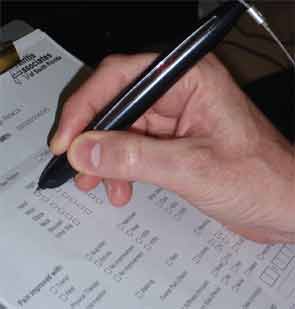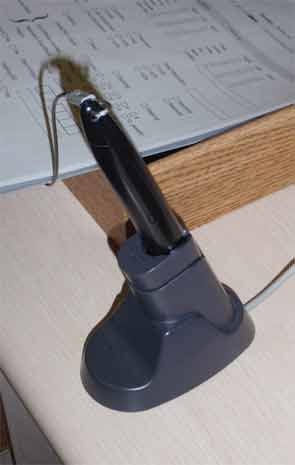When Steven Goodman, MD, a rheumatologist at Arthritis Associates of South Florida in Delray Beach, attended a user meeting for NextGen, the electronic health record (EHR) company, he caught a demonstration of a new tool that looked deceivingly low-tech.
At a glance, it looked like a pen and a piece of paper—your standard gear for patient questionnaires filled out in the waiting room before being called back for an office visit.
But the pen is actually a mini-computer, called NextPen, with a digital camera on the end of it. It can identify that particular sheet of paper, which has a unique dot pattern that looks like light-gray shading, then store the information marked down on the paper. Then, when inserted into a dock, it can load that information straight onto a computer, where the dot pattern is linked to a patient, and then into that patient’s EHR.
Dr. Goodman, who first saw the technology two years ago, was immediately enamored and wasted little time.
“We preordered them before they were even available,” he says. He has used it for about a year and a half.
Dr. Goodman says the technology has been well worth it, saving time in gathering patient’s medical information, which streamlines office visits, and in converting long-time patients’ demographic information to electronic form.
Making Their Mark
Digital pen technology for health records has been used in the United States since about 2005, with the market dominated by the Swiss-company Anoto, which developed the NextPen for use with the NextGen EHR system.

The pens are making even more inroads lately as doctors’ offices are moving to electronic records.
“We saw this as an opportunity to provide a solution to that problem and make it simple enough to capture that structured data that we could ease the transition to EMR,” says Roy Feague, vice president of development at NextGen.

The Anoto pens, which go by many names, can be used with other EHR systems, but they are generally linked with the existing system through third-party companies. In the case of the NextPen version, the pen is designed specifically for use with the NextGen system so that a new interface doesn’t have to be created for each new piece of data, which can come at a significant added expense, Feague says.

The cost of the NextPen varies, based on how many you buy. The start-up cost for one NextPen is about $1,385—which includes $1,000 in software licensing fees, plus the pen hardware and other fees of $385, Feague says.
Fitting into the Routine
The pen is designed to integrate with the systems in an existing office. The paper with the dot pattern that allows the pen to identify it is normal office copy paper that can be printed on a regular laser printer. There are no per-page fees.
The information loaded onto the pen as forms are filled out cannot be linked to any patients until the pen is docked, Feague noted.
“The pen doesn’t actually know which patient it is, the pen just knows that it sees a certain dot pattern,” he says.
Plus, patients and doctors accustomed to using pen and paper don’t feel as though they’re doing anything unusual, Dr. Goodman says.
He says there has been little difficulty in having patients use the technology.
“They don’t realize what they’re doing. They’re filling out a sheet of paper like they would in any doctor’s office,” he says. “So it’s not difficult for a patient to interface with your electronic health record because they’re using tools that they’re used to, which are a pen and a piece of paper.”
Anoto marketing director Virginia Carpenter says that’s been one of the draws for doctors wanting to use the pens to transition to EHR. She says she’s heard that doctors are not so much scared off by the cost of transitioning, but the interruption of workflow.
It’s not difficult for a patient to interface with your electronic health record because they’re using tools that they’re used to, which are a pen and a piece of paper.
—Steven Goodman, MD
“Bringing tablets or laptops in, training staff on how to navigate through the screens—the whole new way of doing the process when they’ve been doing something else probably for a long time,” she says. “The beauty of our technology is that there really is no workflow interruption from a user’s point of view.”
Dr. Goodman has found that to be the case—and he has saved money, compared to the $100,000 some companies wanted to convert the office’s thousands of paper files to PDFs.
“You can have the patient fill out a form and put their information in there for you,” he says. “What a cost savings.”
He says learning about a patient’s progress, or problems—like where they’re having pain, and what helps with it and what makes it worse—from a precompleted electronic form is a time saver.
“This takes a few minutes of my office visit,” he says. “When this is done for me in advance, I have a couple of extra minutes. I can use that time for other purposes with the patient, addressing other issues, and being a better doctor.”
His office soon plans to introduce a new form patients will be able to fill out and have their Routine Assessment of Pain Index Data 3 (RAPID3) automatically calculated.
Arthritis Associates office manager Dawn DeCelles says patients have responded well.
“We’ve gotten a lot of good feedback,” she says. “There’s not a whole lot of people who want to fill out forms, but when you … explain the technology to them, it’s ‘Oh really? Wow.’ ”
She says it’s helped with satisfying the federal Meaningful Use requirement on EHR use.
“I think it’s great. It’s really helped us to achieve some of those key measures for Meaningful Use, which is very big right now,” DeCelles says. “Because it’s hard to get the staff to remember to click in every little box and even get the information from the patient. So to me it’s been a huge [help] in obtaining that.”
Thomas Collins is a freelance medical writer based in Florida.

